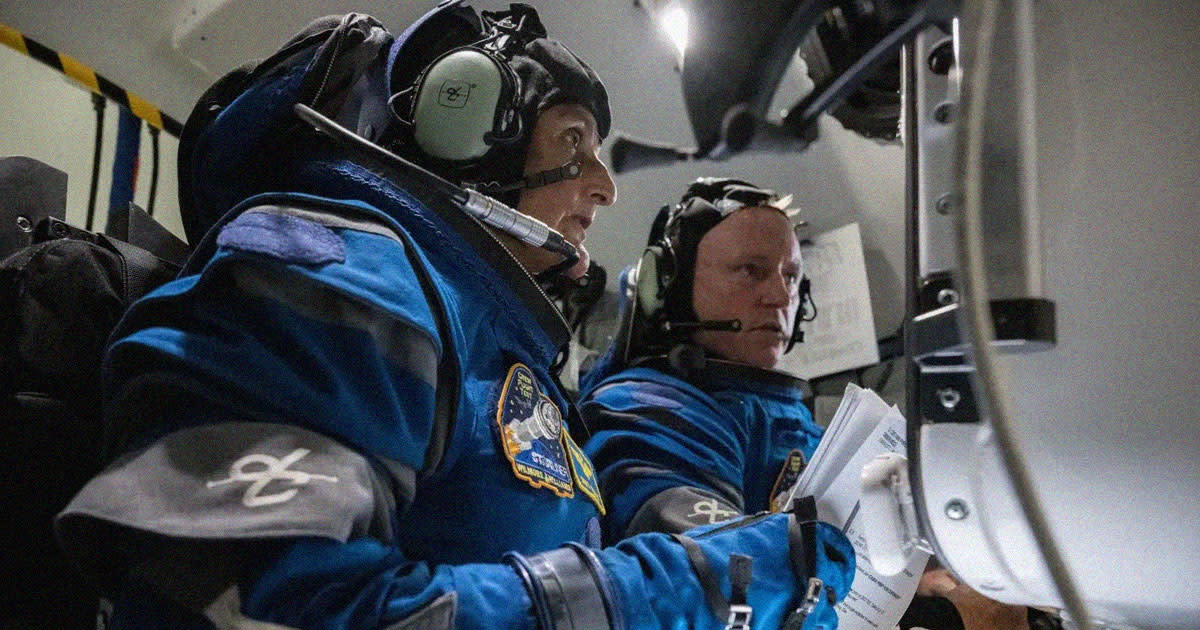NASA Says If Necessary, SpaceX Could Come Rescue the Astronauts Stranded by Boeing

Despite being stranded on board the International Space Station, the crew of Boeing's plagued Starliner are still in good spirits.
During a Wednesday live stream, NASA astronauts Butch Wilmore and Sunita Williams affirmed that they're "absolutely confident" in the spacecraft, which sprung several helium leaks on its way to the orbital outpost last month.
The capsule has been the subject of much debate, with the space agency reassuring that its overheating thrusters, which allow it to maneuver through the microgravity of space, aren't a serious problem.
Starliner is currently one of just three spacecraft currently docked to the ISS. In total, there are nine crew members currently on board the station, including Wilmore and Williams. Four of them arrived at the station on May 2 on board the Crew Dragon Harmony. The remaining three arrived at the station in late March on board the Soyuz MS-25 capsule.
All of the seats in both Harmony and MS-25 would be occupied in the event of an emergency, suggesting that Wilmore and Williams would have to resort to Starliner.
And they already had some practice. Late last month, NASA instructed all crew members to shelter in their respective spacecraft after reports indicated pieces of a broken-up satellite were headed their way.
NASA has also maintained that the two stranded astronauts could easily make it back to the surface inside the Starliner in the case of an emergency, despite the ongoing technical issues.
Crew Dragon and Starliner were developed under the same NASA Commercial Crew program. But while SpaceX has successfully launched 12 crewed missions since 2020, including eight crew rotational journeys to the ISS, Boeing only launched its first crewed test flight last month.
And if Starliner were to be deemed unfit for its return journey, NASA would presumably have to come up with a plan B: launching another Crew Dragon spacecraft — or possibly a Soyuz, though that's a far less likely option given the high costs and geopolitical ramifications.
NASA's manager of the program Steve Stich initially denied that there were any plans to have the stranded pair of astronauts get a ride home on board an additional Crew Dragon spacecraft.
"There’s really been no discussion with sending another Dragon to rescue the Starliner crew," Stich said during a Wednesday press conference, as quoted by the New York Times. Stich added that the pair will likely return on Starliner by the end of the month, roughly a month and a half after the initially scheduled return date of June 14.
But Stich stopped short of ruling out the possibility.
"The beautiful thing about the commercial crew program is that we have two vehicles, two different systems, that we could use to return crew," he said. "So we have a little bit more time to go through the data and then make a decision as to whether we need to do anything different."
"But the prime option today is to return Butch and Suni on Starliner," he added. "Right now, we don’t see any reason that wouldn’t be the case."
Emphasis on "prime" — while NASA is still hoping to use Boeing's hobbled astronaut shuttle for Williams and Wilmore's return journey, Stich's ambiguous and likely carefully worded statements suggest that the agency is also prepared to load the pair into a Crew Dragon if push comes to shove.
In the meantime, engineers are hard at work figuring out why five of Starliner's 28 reaction control system thrusters are acting up. Four of them sprang back into action during docking with the ISS last month, but still aren't working to their full potential.
"You could tell it was degraded, but still, it was impressive," Wilmore said during this week's live stream.
The thrusters have a very straightforward job in the pair's upcoming trip back to the surface. While they're not providing the deorbit burn themselves, they help orient the spacecraft, as Ars Technica explained.
"What we want to know is that the thrusters can perform; if whatever their percentage of thrust is, we can put it into a package that will get us a deorbit burn," Williams said. "That's the main purpose that we need [for] the service module: to get us a good deorbit burn so that we can come back."
The pair maintain that all of this is par for the course for an entirely new and unproven spacecraft, though there were no comparable struggles with SpaceX's first Crew Dragon flight to the station.
"This is a tough business that we're in," Wilmore argued. "Human spaceflight is not easy in any regime, and there have been multiple issues with any spacecraft that’s ever been designed, and that’s the nature of what we do."
More on Starliner: Stranded Astronauts "Absolutely Confident" in Boeing's Leaky Starliner


